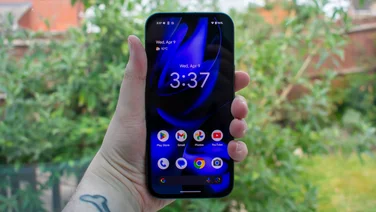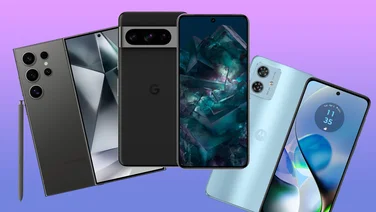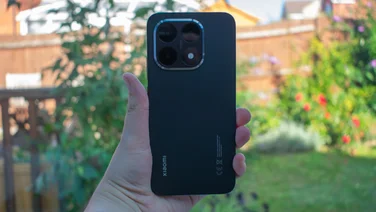To help us provide you with free impartial advice, we may earn a commission if you buy through links on our site. Learn more


























- Class-leading performance
- … and battery life
- Exquisite cameras
- More generic design
- Not the longest software support
- Heavy-handed AI with zoom photography
Fans of sequential ordering, brace yourselves, because OnePlus is skipping a generation and following the OnePlus 13 with the OnePlus 15. The reasoning? This latest flagship smartphone is such an advancement over its predecessor that it counts as two generational leaps, rather than the annual incremental improvement we usually get.
Having exhaustively tested the OnePlus 15, that feels like marketing guff to me. This is a single-generation improvement – albeit a very, very good one. Performance is outstanding, the cameras are sharp and versatile, the display is flawless and battery life is the best that we’ve ever tested on a smartphone by an incredible margin.
For a price that continues to undercut the rest of the flagship competition, the OnePlus 15 is the best value for money you can get from a phone right now.
OnePlus 15: What you need to know
OnePlus is really shaking things up this year. In addition to skipping the 14 model entirely, it has also made the controversial decision to release the follow up to the OnePlus 13 in the same calendar year, dropping the OnePlus 15 roughly 11 months later, instead of the expected January release.
So what’s the big rush? Part of the reason could be that OnePlus has secured the honour of being the first phone to reach UK shores with the new Snapdragon 8 Elite Gen 5 chipset. This processor is clocked at up to 4.6GHz and it’s paired here with either 12GB of RAM and 256GB of storage or 16GB/512GB.


























Another stand-out inclusion is the massive 7,300mAh battery, which is considerably higher in capacity than we tend to see from flagship phones in this part of the world. The OnePlus 13, for instance, had a 6,000mAh battery, and many rivals sit closer to 5,000mAh.
The display is slightly smaller than the OnePlus 13’s, down from 6.82in to 6.78in, and the resolution is weaker (2,772 x 1,272 compared to 3,168 x 1,440). The refresh rate is improved, however, bumping up from 120Hz to 165Hz.
The same 32MP (f/2.4) selfie camera sits in a holepunch notch near the top of the display, while on the rear we have three 50MP lenses: the main camera has an aperture of f/1.8, the 3x telephoto camera is f/2.8 and the ultrawide is f/2.0.
Price and competition
On top of being the first Snapdragon 8 Elite Gen 5-powered phone to reach our shores, the OnePlus 15 is also likely to be the cheapest. OnePlus flagships have consistently undercut the competition in previous years, and it shows no signs of fixing what ain’t broke.
In fact, this time, it’s decided to undercut itself. The 12GB/256GB model costs £849, which is £50 less than its equivalent OnePlus 13 configuration, while the 16GB/512GB variant is £979 – £20 less than its predecessor. Considering all the upgrades on offer here, that’s fairly incredible.
Speaking of offers, OnePlus is also running an introductory discount, getting you £100 off the 16GB/512GB model. Buy before 12 December and you can grab the higher-storage OnePlus 15 for just £879.


























Until more Snapdragon 8 Elite Gen 5 handsets hit shelves (likely from early 2026), the OnePlus 15 stands unique among Android phones. Its biggest rivals are the likes of the Samsung Galaxy S25 Ultra, Honor Magic 7 Pro and Xiaomi 15 Ultra – though all of these are a little long in the tooth, by smartphone standards, and are due to be surpassed by newer models within the next couple of months.
In fact, the only real equivalent that the OnePlus 15 has at the time of writing is the iPhone 17 Pro Max. Released mere weeks ago (and also featuring an ugly redesign) Apple’s latest high-end phone offers incredible performance, gorgeous cameras and the best battery life of any Apple phone we’ve tested. It starts at £1,199 for the 256GB model, with the 512GB at £1,399, the 1TB at £1,599 and, for the first time on any smartphone, you can get a 2TB configuration for an eye-watering £1,999.
Design and key features
It’s not just the internal components that are different this time around: the OnePlus 15 has undergone quite a dramatic redesign, and I don’t think it’s for the better.
First, the positives. It still feels nicely manageable in the hand: its 77 x 161mm (WxH) footprint is roughly the same as the OnePlus 13, and it’s a little slimmer, at 8.1mm thick, compared to 8.5mm. It also weighs around the same as its predecessor, at either 211g or 215g, depending on which finish you choose.


























There are three styles available. My review sample came in the Sand Storm colourway and pairs a silky smooth fibreglass rear with a micro ARC oxidised (MAO) metal frame that is apparently 1.3x harder than titanium mid-frames. It also feels lovely in the hand, with its hard, cool surface resembling ceramic more than metal – although as with the anodisation on Apple’s latest iPhones, I’m cautious about the coating wearing away on the sharp corners.
If that doesn’t float your boat, you can also get a more traditional look with the Infinite Black model – which comes with a frosted glass rear – while the opulent Ultra Violet model shifts colour as it catches the light. It’s an okay selection of colours, and the material choices are definitely interesting, but compared to the elegant Navy Blue OnePlus 13 or the stark Emerald OnePlus 12, it does feel a little muted.
The edges of the phone are flat this time around, which makes the OnePlus 15 look a little chunkier than its predecessor, despite being thinner. I also don’t love the new camera module, which has traded in an off-center circle for a rounded square in the top-left corner, better complying to the Apple playbook. It’s not aggressively ugly, it’s just an altogether more generic look that lacks the unique design language that OnePlus phones used to be known for.


























Otherwise, this is about as high-end as phones get. Connectivity support now extends to Wi-Fi 7 and Bluetooth 6.0, there’s a layer of Gorilla Glass Victus 2 over the display for scratch protection and the phone is rated IP68/IP69 for dust and water resistance. The latter means that it’s fully dust tight, able to withstand high-temperature, high-pressure jets of water and can survive a 1.5m dunk in fresh water for up to 30 minutes – though OnePlus claims it can actually dip down to two meters and still come out functioning.
The phone runs Android 16 out of the box, with OnePlus’ OxygenOS launcher sitting over the top. This is a sleek and accessible OS but it annoyed me from the off with the amount of preinstalled bloatware clogging the homescreen. Another downside is you don’t get as much software support here as other flagships, with four years of OS updates and six years of security patches – Google, Samsung and Honor all offer seven years apiece.
Perhaps the most controversial design change is the removal of the iconic alert slider on the left edge, replaced here with the same Plus Key we saw on the OnePlus Nord 5. For my money, this is a good change, as it still allows you to set the function of the key to cycling between loud, vibrate and silent – essentially replicating the alert slider – while also opening the door to other options, including toggling the torch, opening the camera or – the default – saving content to the OnePlus Mind Space.


























The latter is an AI-infused collection of screenshots and audio notes, where you can gather thoughts, reminders and references, which will then be intelligently grouped into folders for easier location later on. Google Gemini is integrated, too, allowing you to ask the AI questions about your saved content. It’s one of my preferred implementations of AI – tied with the almost identical Essential Space that debuted with the Nothing Phone (3a) series – as it mostly stays out of the way while offering up something that is actually useful.
Display
The 6.78in AMOLED display is a tiny bit smaller than its predecessor and the 2,772 x 1,272 resolution isn’t as sharp, but neither are dramatic enough a drop to be dealbreakers. Moreover, there are some positives in play here, too: the display is surrounded on all sides by miniscule 1.15mm bezels – easily among the slimmest I’ve ever seen on a phone – and the refresh rate has been upped to a breezy 165Hz.
There are realistically few scenarios in which you’ll notice this upgrade over the previous 120Hz screen, but it’s still nice to have – and this is an LTPO panel, too, so the refresh rate can dynamically adjust all the way down 1Hz, for improved power efficiency.


























Testing with my trusty colorimeter also confirmed that the OnePlus 15’s display is as technically proficient as ever: brightness peaked around 769cd/m2 on manual mode, rising to 1,102cd/m2 on adaptive mode with a torch shining on the light sensor and topping out at 1,463cd/m2 when displaying HDR content.
There are three colour profiles, with Vivid punching up the shades to make your movies and games really pop, while Natural and Standard keep colours accurate to sRGB, with the latter being a little warmer than the former. Standard delivered the best colour accuracy in my testing, with an sRGB gamut of 98.6% against a volume of 101.6%, and the average Delta E colour variance score came back at 0.91 – anything under 1 is essentially perfect.
Performance and battery life
The leap from Snapdragon 8 Elite to Snapdragon 8 Elite Gen 5 isn’t the most substantial generational improvement we’ve ever seen – the OnePlus 15’s Geekbench 6 multi-core scores are only 3% faster than the Snapdragon 8 Elite for Galaxy used in the Samsung Galaxy S25 Ultra – but it still comfortably delivers the best Android results we’ve recorded.
Single-core scores bested all other Android phones – surpassing the Samsung Galaxy S25 Ultra by 16% – but Apple’s silicon does marginally better, with the iPhone 17 Pro Max holding an 8% lead over the OnePlus.
The OnePlus 15 just about pips Apple to deliver the strongest multi-core scores of any phone we’ve tested to date, passing the iPhone 17 Pro Max by around 4%. Put simply, this is a ridiculously powerful phone and will easily handle whatever strenuous multi-tasking you throw at it.
The onscreen results for OnePlus phones consistently get locked at 60fps in the GFXBench GPU test, so that isn’t an accurate representation of power. Look instead at the offscreen results and you’ll see that the OnePlus 15 wipes the floor with the competition.
This translates into beautifully smooth and fluid 3D gameplay, with no hint of lag or stuttering, even when dealing with the highest level of graphics. I ran Genshin: Impact with all of the sliders set to maximum and, even though the app warned me that my phone may overheat (it didn’t), it still ran perfectly, delivering those crisp visuals at a solid 60fps.
I knew from the very first spec sheet that the OnePlus 15 was going to be a gamechanger for battery life; between the new, enormous 7,300mAh “Silicon NanoStack” battery and the expected performance efficiency of the Snapdragon 8 Elite Gen 5 processor, OnePlus is throwing everything and the kitchen sink at the stamina stakes this year.
“Silicon NanoStack” isn’t just marketing word salad, it actually means something in this case. The NanoStack bit refers to the fact that the battery in the OnePlus is made up of two cells stacked on top of each other, each with a capacity of 3,650mAh, giving a total of 7,300mAh.
The Silicon bit means the cells use silicon particles in the anodes, which have a higher capacity to store lithium ions and can therefore be used to improve a battery’s energy density – delivering higher capacity without requiring more physical space.
And it absolutely pays off. In our standardised looping video battery test, with all data connections disabled and the brightness set to 170cd/m2, the OnePlus 15 lasted for a staggering 45hrs 12mins before finally switching off. That is, by far, the best battery life result we’ve ever recorded, beating the next best score – the iPhone 17 Pro Max – by just over seven hours.
Wired charging supports speeds up to 120W and wireless goes up to 50W. Despite having such a gargantuan battery to fill, I was fairly impressed with how quickly the OnePlus 15 managed to juice back up in testing. It took 23 minutes to hit 50% from empty and it reached 100% in under 50mins.
Cameras
At first glance, the camera suite feels like something of a downgrade compared to the OnePlus 13. There are some small changes to the hardware – the main camera has a marginally narrower f/1.8 aperture and the telephoto camera uses a smaller 1/2.76in sensor, but the most notable difference is that these lenses are no longer manufactured in tandem with the photography legends at Hasselblad.
This means you no longer have access to the Hasselblad-developed filters and the colouring is now courtesy of OnePlus’ home-grown imaging engine. The former may be a disappointment to some but the latter is certainly no bad thing.
The colours are still gorgeous on the 50-megapixel main camera, sticking with a natural, more true-to-life look by default. Detail level is as excellent as ever, too, and the broad dynamic range does a great job at keeping shadows nice and moody while still retaining the bright highlights in elements such as clouds.

The 50-megapixel (f/2.8) telephoto camera doesn’t suffer for using a smaller sensor – light intake is still brilliant, producing crisp and well-exposed shots at the 3.5x optical zoom.

Hybrid zooms up to around 20x maintain good detail retention, but beyond that you’ll start to see some heavy AI smoothing to counteract the blurring. By the time we reach the maximum of 120x magnification, the results look very plasticky and artificial.

The 50-megapixel (f/2.0) ultrawide camera impressed in testing, as well, broadly matching the colour tone of the other two rear lenses and keeping detail levels looking sharp. Even the traditionally tricky corner areas aren’t massively more blurry than the rest of the image.

Rounding out the suite are a 32-megapixel (f/2.4) selfie camera that captures sharp portraits with rich skin tones, and video capability that delivers 4K/60fps footage, fully stabilised, as well as options for 4K at 120fps and 8K at 30fps – albeit without the stabilisation. There are also options to record Dolby Vision HDR footage in 4K at 120fps or shoot LOG footage for greater flexibility in colour grading.
In short, this is an incredibly deep, versatile collection of video recording options, putting the OnePlus 15 almost on par with the class-leading Apple iPhone 17 Pro Max.
OnePlus 15: Verdict
The OnePlus 15 is, for the most part, a ridiculous bargain. Performance, battery life, display quality and camera prowess are all either class-leading or up there with the best.
Only two areas show the OnePlus 15’s more affordable nature compared to the most premium flagships. Software support is still shorter than all of the top dogs and zoom photography isn’t as competent when you get past 30x. I suspect that the upcoming Samsung Galaxy S26 Ultra and Honor Magic 8 Pro will prove better in both regards – though both will also cost more than this.
For its (relatively) low flagship price, the OnePlus 15 delivers in all regards that matter, offering unbeatable value that I doubt will be surpassed in the upcoming year of smartphone releases. In terms of sheer bang for your buck, the OnePlus 15 is simply without equal.





